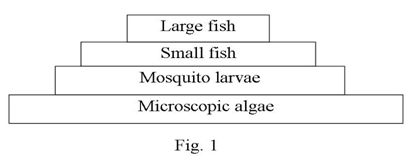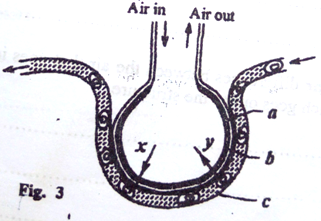1. The relationship between fungi and algae in lichen is best described which are all for wind –dispersed fruits and light.
A. mutualistic
B. parasitic
C. Predatory.
D. Symbiotic
2. Which one of the following contains a set of characteristics which are all for wind-dispersed fruits and seeds?
A. Parachute-like, hooked and light.
B. Dry, curled inwards and spiked.
C. Parachute-like, winged and light.
D. Succulent, buoyant and light.
3. In plant, efficient gaseous exchange due to large surface to volume ratio is achieved by
A. Many stomata on leaves.
B. Flatness of leaves
C. Large sized lenticels
D. Numerous root hairs.
4.. Which of the following would happen if a torch was show n directly into a person’s eye?
A. Iris muscles would contract, narrowing the pupil.
B. Lens would bilge, allowing less light to enter.
C. iris muscles would re lax, narrowing the pull
D. Lens would flatten, diverging light rays.
5. The following A results of an experiment to determine percentage of water within a sample of soil
Mass of crucible =15g
Mass of crucible +soil =30g
Mass of crucible +soil after drying =25g
The percentage of water in the soil is
A. 18.7
B. 20.0
C. 33.3
D. 66.7
6. In peas, yellow seed colour is dominant over green seed colour .what would be the phenotype of the offspring if A true breeding yellow-seeded plant is crossed with a green-seeded plant?
A. 2 yellow: 2 green
B. 3 yellow: 2 green
C. 3 green: 1 yellow
D. All yellow.
7. Which one of the following contains a set of cells which are all haploid?
A. Pollen grain ovules and root hair cells.
B. Sperms pollen grains and ova.
C. Sperms ovules and brain cells.
D. Cells of the epididymis, ovules and ova.
8. Which one of the following sets, consists of bones of the limb?
A. Femur, tibia, humerus.
B. Radius ulna, femur.
C. Tibia, fibula, ulna.
D. Humerus, radius, ulna.
9. Which one of the following organs is supplied and drained by a vein?
A. Stomach.
B. Liver
C. Kidney
D. Pancreas.
10. Figure 1 is a pyramid of number s in an ecosystem.

Which one of the following changes would reduce the number of mosquito larvae?
A. Increase in number of large fish.
B. Increase in number of small fish. Decrease the number of small fish.
C. decrease the numbers of the small fish
D. Increase in number of microscopic algae.
11. In the biuret test, the colourr which indicates appositive result is
A. purple
B. Blue
C. Pink
D. Red brown
12. Which one of the following is not correct statement about flower parts?
A. sepals and petals together from perianth
B. Sepal from calyx.
C. Carpels from and corolla.
D. Petals form corolla.
13. Which one of the following occurs to urine as it leaves the kidney to the bladder?
A. Glucose is removed.
B. Urea is added.
C. Its composition remains unchanged
D. Water is removed.
14. Under which one of the following conditions will air enter the mammalian lungs? When the
A. pressure of the thorax is increased
B. Ribs are lowered.
C. Diaphragm is raised
D. Volume of the thorax is increased
15. Which one of the following is a modified tap root?
A. onion bulb
B. carrot tuber
C. Cassava tuber
D. Irish tuber
16. Which one of the following activities generates heat in the human body?
A. shivering of the body
B. Construction of peripheral blood vessels.
C. Contraction of the erector pill muscle.
D. Dilation of the peripheral blood vessels.
17. Plants lack special excretory organs because.
A. Their waste products are less toxic and are sometimes reused
B. They do not produce waste products.
C. They lack vessels to transport the products.
D. Waste products produced are gaseous.
18. In apotometer,the rate of movement of an air bubble correspond to the rate of
A. water uptakes
B. osmosis
C. air movement around the plant
D. Water loss from the reservoir.
19. T o estimate the population of t tilapia using a capture-recapture method, 60 fish were captured, marked and released. in the second capture ,out of 72 fish, 10 had been marked .the estimated population of tilapia was
A. 672
B. 780.
C. 432.
D. 4310.
20. To which one of the following groups of plants do mosses belong?
A. Pteridophytes.
B. Bryophytes.
C. angiosperm
D. Conifers.
21. Which one of the following activities is likely to increase the level of carbon dioxide in in the atmosphere?
A. Cutting down trees.
B. Using artificial fertilizers?
C. Discharging waste in water bodies.
D. Using pesticides.
22. A radical of seedling grows down ward s because the concentration of auxin is
A. Higher on its lower side, promoting growth on that side.
B. Lower on its lower side, promoting growth on that side.
C. Higher on its upper side, promoting growth on the side.
D. Lower on its upper side, promoting growth on that side.
23. Which one of the following activities results into upstroke during flight in bird s?
A. Movement of the humerus downwards.
B. Contraction of small flight muscles and relaxation of small flight muscles,
C. Contraction of small flight muscles and relaxation of large flight muscles.
D. Faster air movement on upper surface than lower surface of wings
24. Which of the following are characteristics of wind –pollinated flowers?
A. Feathery stigmas and smooth pollen grain.
B. Stigmas growing higher than stamens
C. Free stamens growing higher than the stigma.
D. Large pollen grains on firm anthers.
25. Identical twins result from
A. One ovum being fertilized by one sperm.
B. An ovum splitting into two before festination.
C. Two ova being fertilized by one sperm
D. Two ova being fertilized by two sperms.
26. Which one of the following statements describes hypogeal germination?
A. Hypocotyl elongate, leaving cotyledons below the ground.
B. Epicotyl elongates, bringing cotyledons above the ground.
C. Hypocotyl elongate, bringing cotyledons above the ground.
D. Epicotyl elongates, bringing cotyledons above the ground.
27. Which one of the following groups of bacteria convert soil nitrates to free nitrogen?
A. Nitrifying bacteria.
B. Nitrogen fixing bacteria.
C. denitrifying bacteria
D. putrefying bacteria
28. An albino offspring is likely to result from across between
A. An albino father and a normal mother.
B. Both parents who are carriers for albinism.
C. a carrier mother for albinism and a normal father
D. Both parents who are normal.
29. a sexual reproduce in a rhizopus results into
A. zygospores
B. Buds.
C. fragments
D. Spores.
30. Which one of the following is the route a red blood cell takes from the liver to the lungs?
A. Hepatic portal vein, vena cove, pulmonary artery.
B. Hepatic artery, aorta, pulmonary artery.
C. Hepatic artery, aorta pulmonary artery.
D. Hepatic vein vena cava, pulmonary artery.
31. Rats are herbivores that usually live in human dwelling which are filthy. Bacteria of the species pasteurella pestis, live in and feed on the blood of the rat. Fleas feeding on the blood of the rat stuck up the bacteria feed on human blood too, and this sometimes results into human developing bubonic plague.
(a) In the space below, draw a food web to show the feeding relationships described.
(b) Which organisms are
(i) Parasites
(ii) Vectors
(c) Suggest the name of the producer for the food web and explain how it would enter the food web.
(d) From the information given,
(i) State the trophic le levels in the food web and give one organism in each level
(ii) Describe what would happen if rats were removed from the food web.
32. Figure2 (i) and (ii) and(iii) show the rate of photosynthesis under different condition

(a) State what each figure shows
Figure 2 (i)
Figure 2 (ii)
Figure 2 (iii)
(b) Describe what happens in each figure
Figure 2 (i)
Figure 2 (ii)
Figure 2 (iii)
(c) Explain the shape of figure 2 (iii)
(d) From figure 2 (i), 2(ii) and 2(iii), state the factors that the rate of photosynthesis.
34 (a) Explain how a plant benefits from transpiration.
(b) Describe how lands in arid areas control excessive loss of water.
35. Describe the processes that occur after pollination in flowering plant leading to the formation of a fruit
33. Figure 3 shows a structure in the mammalian lung, study the figure and answer the questions that fellow;

(a) Name the
(i) Parts labeled a, b, and c
(ii) Gases indicated by arrows X and y
(b) Show how the features shown in the figure, enable the structure to function efficiently
(c) State four differences between the air that goes into the structure and that which goes out of the structure.
36. (a) Explain the advantages of ectothermy and endothermy.
(b) a shrew is the smallest mammal in Africa. It eats a lot of food which is mainly insects, rich in fats. Explain why the shrew eats.
(i) lot of food
(ii) Mainly insect s rich in fats
37. (a) What is accommodation?
(b) Suppose a boy was sitting in a dimly lit room reading a book, and then he suddenly stepped out of the room into bright sunshine to look at an earorplane in the sky. Describe the sequence of events which would occur in his eyes to eyes to enable him see the aero plane clearly.
(c) Explain why many old people use glasses to read
